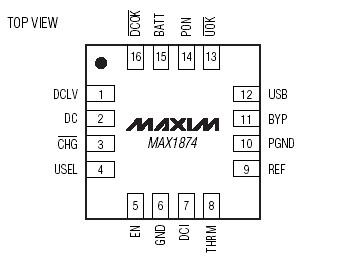MAX1874: Features: Charge from USB* or AC AdapterAutomatic Switchover to AC AdapterThermal Limiting Simplifies Board DesignSmall, High-Power 16-Pin Thin QFN PackageInput Protection Up to 18VSoft-StartAutomat...
floor Price/Ceiling Price
- Part Number:
- MAX1874
- Supply Ability:
- 5000
Price Break
- Qty
- 1~5000
- Unit Price
- Negotiable
- Processing time
- 15 Days
SeekIC Buyer Protection PLUS - newly updated for 2013!
- Escrow Protection.
- Guaranteed refunds.
- Secure payments.
- Learn more >>
Month Sales
268 Transactions
Payment Methods
All payment methods are secure and covered by SeekIC Buyer Protection PLUS.

 MAX1874 Data Sheet
MAX1874 Data Sheet







